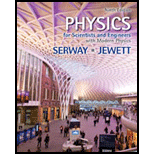
Concept explainers
(a)
The terminal speed for water droplets with a radius of
(a)
Answer to Problem 69CP
The terminal speed for water droplets with a radius of
Explanation of Solution
Write the expression for the magnitude of resistive force exerted on a sphere.
Here,
Write the expression for the force.
Here,
Equating equations (I) and (II),
Write the expression for the density of the water droplet.
Here,
Write the expression for the volume of the water droplet.
Rewrite the expression (IV) for the mass of the water droplet by substituting equation (V).
Conclusion:
Substitute
Substitute
Substitute
Here
Therefore, the terminal speed for water droplets with a radius of
(b)
The terminal speed for water droplets with a radius of
(b)
Answer to Problem 69CP
The terminal speed for water droplets with a radius of
Explanation of Solution
Write the expression for the magnitude of resistive force exerted on a sphere.
Here,
Write the expression for the force.
Here,
Equating the equation (VII) and (VIII),
Write the expression for the density of the water droplet.
Here,
Write the expression for the volume of the water droplet.
Rewrite the expression (X) for the mass of the water droplet and substitute equation (XI).
Conclusion:
Substitute
Substitute
Substitute
Here taking positive root values.
Therefore, the terminal speed for water droplets with a radius of
(c)
The terminal speed for water droplets with a radius of
(c)
Answer to Problem 69CP
The terminal speed for water droplets with a radius of
Explanation of Solution
Write the expression for the magnitude of resistive force exerted on a sphere.
Here,
Write the expression for the force.
Here,
Equating equations (XIII) and (XIV),
From the part b the expression for the mass of the water droplet,
Conclusion:
Substitute
Substitute
Substitute
Here assuming
Therefore, the terminal speed for water droplets with a radius of
Want to see more full solutions like this?
Chapter 6 Solutions
Physics for Scientists and Engineers With Modern Physics
- A vector has a magnitude of 12 units and is directed at angle of 60°C from the positive x-axis. A scalar value of α -2 is multiplied. Determine the new magnitude and direction.arrow_forwardTwo forces act on a 3.20 kg object, the gravitational force and a second, constant force. The object starts from rest and in 1.20 s is displaced (4.35î − 3.30ĵ) m. Write the second force in unit vector notation. (Enter your answer in kg · m/s2. Assume the gravitational force acts in the −ĵ direction.) F =arrow_forwardThree forces act on a point. The forces are represented by colored arrows. The orange force is 10 N @ 105o; the blue force is 8 N @ 210o; and the green force is 15 N @ 315o. Express the net force on that point in both unit vector notation and polar notation.arrow_forward
- A variable force F(x)=Ax2-Bx acts on an object. The units of F(x) are N and the values of A and B are A=6.09 and B=3.18 when x is in meters. The units of A and B are?arrow_forwardThe force F has a magnitude of 590 N. Express F as a vector in terms of the unit vectors i and j. Identify the x and y scalar components of F. Assume F = 590 N, 0 = 31° Answers: F = (i Fx= i Fy || IM F i+ N N Mi INarrow_forwardA stubborn dog is being walked on a leash by its owner. At one point, the dog encounters an interesting scent at some spot on the ground and wants to explore it in detail, but the owner gets impatient and pulls along the leash with force F = (86.4 N)i + (139.6 N)j + (34.8 N)k. (Here the unit vector k is directed vertically upward.) What is the magnitude of the pulling force in N? What angle does the leash make with the vertical?arrow_forward
- A force F1 of magnitude 4.80 units acts at the origin in a direction 50.0° above the positive x axis. A second force F2 of magnitude 5.00 units acts at the origin in the direction of the positive y axis. Find graphically the magnitude and direction of the resultant force F1 + F2. Find magnitude Find directionarrow_forwardTwo forces act on an object. The first force has a magnitude of 17.0 N17.0 N and is oriented 68.0°68.0° counterclockwise from the +?+x‑axis, whereas the second force has ?x‑ and ?y‑components (−21.0 N,12.5 N).(−21.0 N,12.5 N). Express the magnitude and direction of the net force. magnitude: NN direction: °° counterclockwise from the +?+x‑axisarrow_forwardA 1.80x10^4 kg semi-trailer truck drives up a 200 m hill [θ = 30 degrees above horizontal], at a constant speed of 25.0 m/s. The force of friction is 6.00x10^2 N. Write an equation to isolate and solve for P.arrow_forward
- The force F has a magnitude of 610 N. Express F as a vector in terms of the unit vectors i and j. Identify the x and y scalar components of F. Assume F = 610 N, 0 = 40° Answers: F = (1 DN Fx= i i İ+ N Narrow_forwardA patient with a dislocated shoulder is put into a traction apparatus as shown in the figure. The pulls A and B have equal magnitudes and must combine to produce an outward traction force of 5.52 N on the patient's arm. How large should these pulls be? Figure P1.61 32 32arrow_forwardFor Problems 1 and 2, use the following formula to describe the magnitude of a drag force: 1 D = — -CA pv² 2 FD Problem 1: When a car is traveling at a speed of 30 km/h, it experiences a drag force of magnitude F. If the car increases its speed to 40 km/h, what then will be the drag force it experiences? Assume the drag force is proportional to the square of speed.arrow_forward
 Principles of Physics: A Calculus-Based TextPhysicsISBN:9781133104261Author:Raymond A. Serway, John W. JewettPublisher:Cengage Learning
Principles of Physics: A Calculus-Based TextPhysicsISBN:9781133104261Author:Raymond A. Serway, John W. JewettPublisher:Cengage Learning
